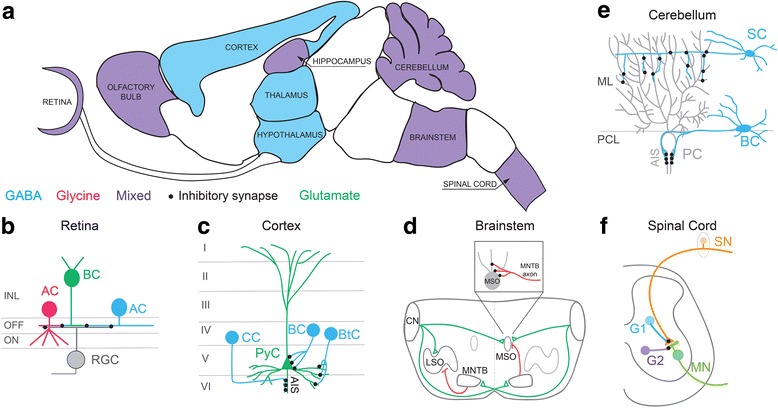Fig. 1.

Types of inhibitory circuits across the CNS. a Modulation of neuronal activity in many CNS regions relies primarily on GABAergic inhibition (blue regions), whereas other regions engage both GABAergic and glycinergic inhibition (purple regions; mixed). In regions such as the retina, GABA and glycine are often released by separate populations of inhibitory neurons. However, inhibitory neurons in the spinal cord can co-release both transmitter types. Sagittal outline of the mouse brain adapted from the GENSAT brain atlas [153]. b-f Schematics showing outline of inhibitory circuits discussed in the review. Some circuits show laminar organization (b, c, e), and interneurons typically target specific subcellular compartments of their postsynaptic partners (b-f). b Schematic of the retina showing glycinergic and GABAergic amacrine cells (AC) contacting glutamatergic bipolar cells (BC) and retinal ganglion cells (RGC) in OFF and ON subdivisions of the inner nuclear layer (INL). [13–15]. (c) In the primary cortex, multiple types of GABAergic interneurons (blue) synapse onto glutamatergic pyramidal cells (PyC, green), each interneuron targeting a specific subcellular location on the PyC. For example, chandelier cells (CC) form synapses onto PyC axon initial segments (AIS). Cortical basket cells (BC) and bitufted cells (BtC) form synapses onto the soma and distal dendrites of PyCs, respectively. Summarized from: [27, 141]. (d) Schematic of circuits between mammalian brainstem nuclei. Dotted grey line represents the midline of the cross-section through the brainstem. The lateral superior olive (LSO) neurons receive excitatory input from the ipsilateral cochlear nucleus (CN) and inhibitory glycinergic input from the ipsilateral medial nucleus of the trapezoid body (MNTB), which is driven by the contralateral CN. Medial superior olive (MSO) neurons receive excitatory input from both ipsi- and contralateral CN, as well as inhibitory glycinergic input from the ipsilateral MNTB. MNTB axons provide glycinergic inhibition onto the soma of MSO neurons. Summarized from [29]. (e) Cerebellar inhibitory circuits. In the cerebellum, GABAergic stellate cells (SC) and basket cells (BC) target distinct subcellular compartments of Purkinje cells (PC). Summarized from [33, 36]. ML: Molecular layer, PCL: Purkinje cell layer, AIS: Axon initial segment. (f) Schematic of a spinal cord inhibitory circuit. Distinct inhibitory interneurons (G1 and G2), which are GABAergic and/or mixed GABA/glycinergic, target sensory afferents (SN) and motor neurons (MN) in the spinal cord, respectively. Summarized from [21, 22]
